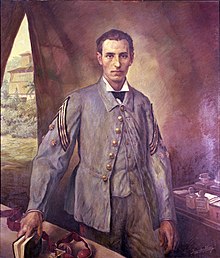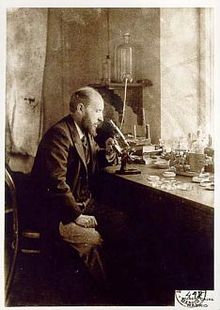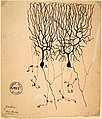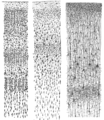Quick Facts
Biography
Santiago Ramón y Cajal (Spanish: [sanˈtjaɣo raˈmon i kaˈxal]; 1 May 1852 – 17 October 1934) was a Spanish pathologist, specializing in neuroanatomy, particularly the histology of the central nervous system. He won the Nobel prize in 1906. His original investigations of the microscopic structure of the brain made him a pioneer of modern neuroscience. Hundreds of his drawings illustrating the delicate arborizations of brain cells are still in use for educational and training purposes.
Biography
Santiago Ramón y Cajal was born 1 May 1852 in the town of Petilla de Aragón, Navarre, Spain. His father was an anatomy teacher
As a child he was transferred many times from one school to another because of behavior that was declared poor, rebellious, and showing an anti-authoritarian attitude. An extreme example of his precociousness and rebelliousness at the age of eleven is his 1863 imprisonment for destroying his neighbor's yard gate with a homemade cannon.
He was an avid painter, artist, and gymnast, but his father neither appreciated nor encouraged these abilities, even though these artistic talents would contribute to his success later in life. In order to tame the unruly character of his son, his father apprenticed him to a shoemaker and barber. "To try and give his son much-needed discipline and stability, Don Justo apprenticed him out to a barber". He was well known for his pugnacious attitude as he worked.

Over the summer of 1868, his father hoped to interest his son in a medical career, and took him to graveyards to find human remains for anatomical study. Sketching bones was a turning point for him and subsequently, he did pursue studies in medicine.
Ramón y Cajal attended the medical school of the University of Zaragoza, where his father was an anatomy teacher. He graduated in 1873, aged 21. After a competitive examination, he served as a medical officer in the Spanish Army. He took part in an expedition to Cuba in 1874–75, where he contracted malaria and tuberculosis. In order to heal, he visited the Panticosa spa-town in the Pyrenees.
After returning to Spain, he received his doctorate in medicine in Madrid in 1877. In 1879, he became the director of the Zaragoza Museum, and he married Silveria Fañanás García, with whom he had four daughters and three sons. Ramón y Cajal worked at the University of Zaragoza until 1883, when he was awarded the position of anatomy professor of the University of Valencia. His early work at these two universities focused on the pathology of inflammation, the microbiology of cholera, and the structure of epithelial cells and tissues.
In 1887 Ramón y Cajal moved to Barcelona for a professorship. There he first learned about Golgi's method, a cell staining method which uses potassium dichromate and silver nitrate to (randomly) stain a few neurons a dark black color, while leaving the surrounding cells transparent. This method, which he improved, was central to his work, allowing him to turn his attention to the central nervous system (brain and spinal cord), in which neurons are so densely intertwined that standard microscopic inspection would be nearly impossible. During this period he made extensive detailed drawings of neural material, covering many species and most major regions of the brain.
In 1892, he became professor at Madrid. in 1899 he became director of the Instituto Nacional de Higiene – translated as National Institute of Hygiene , and in 1922 founder of the Laboratorio de Investigaciones Biológicas – translated as the Laboratory of Biological Investigations , later renamed to the Instituto Cajal, or Cajal Institute.
He died in Madrid on October 17, 1934, at the age of 82, continuing to work even on his deathbed.
Political and religious views
In 1877, the 25 year old Cajal joined a Masonic lodge. John Brande Trend wrote in 1965, that Cajal "was a liberal in politics, an evolutionist in philosophy, an agnostic in religion".
Nonetheless, Cajal used the term soul "without any shame".
He was said to later have regretted having left organized religion, Ultimately, he became convinced of a belief in God as a creator, as stated during his first lecture before the Spanish Royal Academy of Sciences.
Discoveries and theories

Ramón y Cajal made several major contributions to neuroanatomy. He discovered the axonal growth cone, and demonstrated experimentally that the relationship between nerve cells was not continuous, but contiguous. This provided definitive evidence for what Heinrich Waldeyer coined the term neuron theory as opposed to the reticular theory This is now widely considered the foundation of modern neuroscience.
He was an advocate of the existence of dendritic spines, although he did not recognize them as the site of contact from presynaptic cells. He was a proponent of polarization of nerve cell function and his student, Rafael Lorente de Nó, would continue this study of input-output systems into cable theory and some of the earliest circuit analysis of neural structures.
By producing excellent depictions of neural structures and their connectivity and providing detailed descriptions of cell types he discovered a new type of cell, which was subsequently named after him, the interstitial cell of Cajal (ICC). This cell is found interleaved among neurons embedded within the smooth muscles lining the gut, serving as the generator and pacemaker of the slow waves of contraction which move material along the gastrointestinal tract, mediating neurotransmission from motor neurons to smooth muscle cells.
In his 1894 Croonian Lecture, Cajal suggested (in an extended metaphor) that cortical pyramidal cells may become more elaborate with time, as a tree grows and extends its branches.
He devoted a considerable amount of time studying hypnosis which he used to help his wife during labor and parapsychological phenomena. A book he had written on these topics was lost during the Spanish Civil War.
Cajal's efforts to improve the state of scientific research and education in Spain were part of a broader preoccupation with Regenerationism among Spanish intellectuals.
Distinctions

Ramón y Cajal received many prizes, distinctions, and societal memberships during his scientific career, including honorary doctorates in medicine from Cambridge University and Würzburg University and an honorary doctorate in philosophy from Clark University. The most famous distinction he was awarded was the Nobel Prize in Physiology or Medicine in 1906, together with the Italian scientist Camillo Golgi "in recognition of their work on the structure of the nervous system". This caused some controversy because Golgi, a staunch supporter of reticular theory, disagreed with Ramón y Cajal in his view of the neuron doctrine.
Publications
He published more than 100 scientific works and articles in Spanish, French and German. Among his most notable works were:
- Rules and advice on scientific investigation
- Histology
- Degeneration and regeneration of the nervous system
- Manual of normal histology and micrographic technique
- Elements of histology
A list of his books includes:
In 1905, he published five science-fiction stories called "Vacation Stories" under the pen name "Dr. Bacteria".
In society and culture
The asteroid 117413 Ramonycajal has been named in his honor.
In 2014, the National Institutes of Health exhibited original Cajal drawings in its Neuroscience Research Center.
An exhibition called The Beautiful Brain: The Drawings of Santiago Ramón y Cajal travelled through the US beginning 2017 at the Weisman Art Museum in Minneapolis ending April 2019 at the Ackland Art Museum in Chapel Hill, North Carolina.
A short documentary by REDES is available on YouTube Spanish public television filmed a biopic series to commemorate his life.
Gallery of drawings

Drawing of the neural circuitry of the rodent hippocampus. Histologie du Système Nerveux de l'Homme et des Vertébrés, Vols. 1 and 2. A. Maloine. Paris. 1911

Drawing of the cells of the chick cerebellum, from "Estructura de los centros nerviosos de las aves", Madrid, 1905

Drawing of a section through the optic tectum of a sparrow, from "Estructura de los centros nerviosos de las aves", Madrid, 1905

From "Structure of the Mammalian Retina" Madrid, 1900

Drawing of Purkinje cells (A) and granule cells (B) from pigeon cerebellum by Santiago Ramón y Cajal, 1899. Instituto Santiago Ramón y Cajal, Madrid, Spain

Drawing of Cajal-Retzius cells, 1891

Drawn in 1899, taken from the book "Comparative study of the sensory areas of the human cortex"

schema of the visual map theory (1898). O=Optic chiasm; C=Visual (and motor) cortex; M, S=Decussating pathways; R, G: Sensory nerves, motor ganglia.







